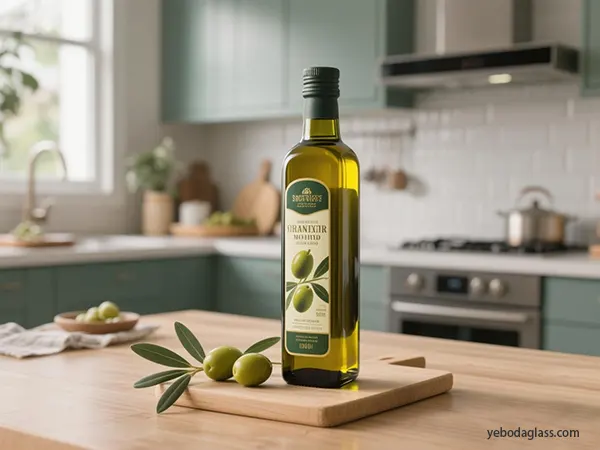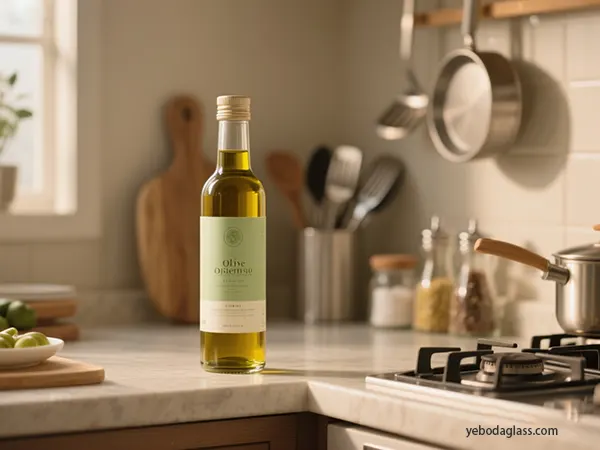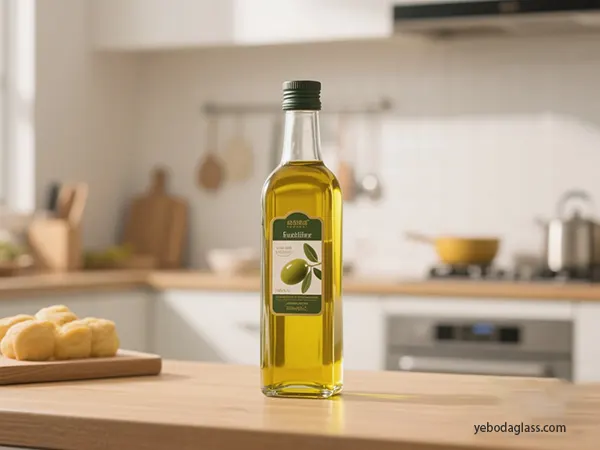Введение
Glass olive oil bottles are an important element of olive oil supply chain, which affects product quality, brand image and profitability. For B2B buyers, it is necessary to optimize the purchase cost of bulk glass olive oil bottle to maintain competition. By infection in a direct supply model, business middlemen can ignore, reduce costs, get better quality control and suppliers strengthen relationships. This report underlines a comprehensive approach to the purchase of bulk glass olive oil bottles, including order definition, design adaptation, sourcing strategies, cost driver analysis, risk mitigation and performance monitoring. Applying these strategies allow companies to optimize both the total cost (TCO), which ensures permanent supply chain efficiency.

Glass Olive Oil Bottles "Bulk" and Order Parameter
Understand Wholesale in Purchase
The term “wholesale” is directly related to achieving economies of scale scale in terms of glass olive oil bottles. The minimum order volume (MOQ) usually ranges from 3,000 to 10,000 units for standard bottles, and may be more for custom design or special colors. Food-grade bottles from some factories may require about 6,000 pieces.
Strategies to Manage MOQs
Negotiating MOQs can be achieved through:
- Září 4, 2025
- Paying slightly higher per-unit costs for smaller batches
- Consolidating orders across multiple product lines
- Using AI-driven demand forecasting to optimize batch sizes
Production Capacity Alignment
Understanding the manufacturer’s production capacity ensures alignment with the needs of purchase. By taking advantage of complete production runs and reducing the passive time, large orders reduce costs per-unit.
Bottle Design and Adaptation Options for Glass Olive Oil Bottles
Adaptation for Brand Discrimination
Custom glass olive oil bottles provide separate brand recognition and product protection. The cost design is affected by complexity, glass color and tooling requirements. For example, the cost of a custom mold for a 750 ml bottle can be $ 1,500-$ 11,000 USD, while the sample verification can add approximately $ 800 USD.
Surface Treatments and Printing Options
Brands can customize bottles with:
- Silkscreen printing
- Labels tailored to branding needs
- Unique closure caps and tailored shapes
- Tinted or UV-Protective Glass Cottings
These adaptations not only enhance aesthetics, but also serve as anti-opposing measures.
Balance Cost and Adaptation
While adaptation upfront increases investment, it gives consumers a premium perception and can separate products in a competitive market. Companies should balance mold costs, mOQs and production complexity with prolonged brand benefits.

Geographical Sourcing and Supply Series Analysis
Major Manufacturing Hub
Global production of glass olive oil bottles focuses in many areas:
- China (Xuzhou, Jiangsu Province): Miscellaneous glass bottle offers styles and adaptation services
- Italy (eg, Vatroolite): famous for high quality glass and design expertise
- Europe (Berlin Packaging Emea): extensive networks in many countries
- India (Firozabad region): Emerging supplier with competitive pricing
- Северная Америка: Primarily through distribution networks rather than primary manufacturing
Evaluating Sourcing Regions
Factors to consider include:
- Logistics efficiency and lead times
- Regional specialties in bottle shapes, colors and styles
- Stability initiative and certificate
- Geophysical stability and tariff implications
Logistics and Economic Ideas
Shipping costs and deadline are greatly affected by the original location. Strategic decisions may include:
- Comparing freight costs from Europe vs. Asia
- Considering nearshoring to reduce cross-border risks
- Assessing total landed cost including duties and insurance
Cost Driver Analysis and Savings Opportunities
Manufacturing Cost
Major manufacturing costs for glass olive oil bottles are included:
- Raw goods: silica sand, soda ash, limestone, collet
- Energy: Glass furnaces operate at 1,400-1,600 ° C
- Labor and overhead
- Production process including molding, quality control and finishing
In large production runs, the scale economies can significantly reduce manufacturing costs per-unit.
Packaging and Shipping Costs
- Упаковка: This includes cushioning material, labor and design complexity. Adaptation reduces waste and labor.
- Shipping: The cost of freight, customs, and insurance premiums increases from glass weight. Covering shipments and optimizing the container uses low cost.

Target Savings Strategies
Savings opportunities include:
- Optimizing bottle design for material efficiency
- Bulk raw material procurement
- Localized sourcing to reduce transportation costs
- Lean manufacturing to minimize waste
- Negotiating volume discounts
Direct Supply Model: Vendor Identification and Due Diligence
Developing Vetting Criteria
Future manufacturers involve assessing:
- Certificate (ISO 9001, FDA Compliance)
- Production capacity and measureability
- Quality control procedures (inspection, defect rate, corrective actions)
- regulatory compliance
- financial stability
- Suppliers reputation and reference
Testing Order and Accountability
Bulk glass before committed to olive oil bottles, test orders test product quality, timeliness and communication efficiency. Evaluation of accountability ensures a reliable long -term partnership.
To take advantage of technology for risk management
Suppliers Risk Management Platforms can provide real-time alerts at financial, geopolitical or operational risks. Tools such as Veridion increase transparency and proper hard work efficiency.
Risk evaluation and mitigation
Supply Series Delicateness
Highlights the purchase of dissolution from global sourcing:
- Geophagical program
- Natural disasters
- Epidemic or trade restriction
The mitigation strategies include passshoring, dynamic inventory allocation and security stocks.
Suppliers Quality Management (SQM)
SQM practices include:
- Regular supplier audits
- Performance scorecards
- Continuous KPI monitori
Logistics and Shipping Risks
- Specialized handling and insurance for fragile стеклянные бутылки
- Pre-shipment condition documentation
- Optimal shipment strate
Cybersecurity and Economic Risks
Monitoring for cyberattacks, currency fluctuations, and tariff changes ensures supply chain resilience. Diversifying suppliers geographically mitigates dependency on a single source.
Implementation Roadmap and Performance Monitoring
Phased Implementation
Start with pilot programs for select suppliers or product lines before full-scale rollout of direct sourcing for glass olive oil bottles.
Major Display Indicators (KPI)
Important KPI includes:
- Cost Savings: Purchase Price Variation, Purchase ROI
- Quality: Dosual Rate, Compliance, Return
- Delivery: On-time delivery rate, lead time
- Suppliers Performance: Accountability and Reliability
- Stability: Recycled Material, waste deficiency
Total Cost of Ownership (TCO)

Beyond the procurement price, consider operational, warehousing, insurance and damage costs. An overall TCO analysis ensures that early savings do not occur in high long term expenses.
Continuous improvement and benchmarking
Regular reviews, benchmarking against industry standards, and KPI surveillance enable the ongoing adaptation and supplier development.
Advanced glass bottle coating technologies for UV conservation
UV-Blocking Coatings
UV-sensitive olive oil requires effective packaging. Tin oxides and nanopartical-based obstacles such as coating prevents UV fall without affecting transparency or recycling.
Application Methods
Coatings can be applied through:
- Spraying
- Dipping
- Chemical vapor deposition (CVD)
The uniform application continuously ensures safety and aesthetic appeal.
Supplementary Conservation Technology
The modified atmosphere reduces further oxidation by mixing UV coatings with packaging (MAP) and increases the shelf-life of high quality olive oil in glass olive oil bottles.
Conclusions: Strategic Sourcing for Cost Optiation and Brand Excellence
Bulk glass provides significant cost saving, better quality control and supply chain flexibility in a direct sourcing model for olive oil bottles. Major strategies include:
- Clearly define the order parameters and mOQs
- Design and adaptation for brand discrimination
- Diligence
- Implementing strong KPI and TCO analysis
- Search for advanced technologies such as UV-Protective coatings
A strategic, data-operated approach empowers businesses to secure reliable, cost-effective supply, strengthen the notion of the brand and get long-term competitive benefits in the global olive oil market.




